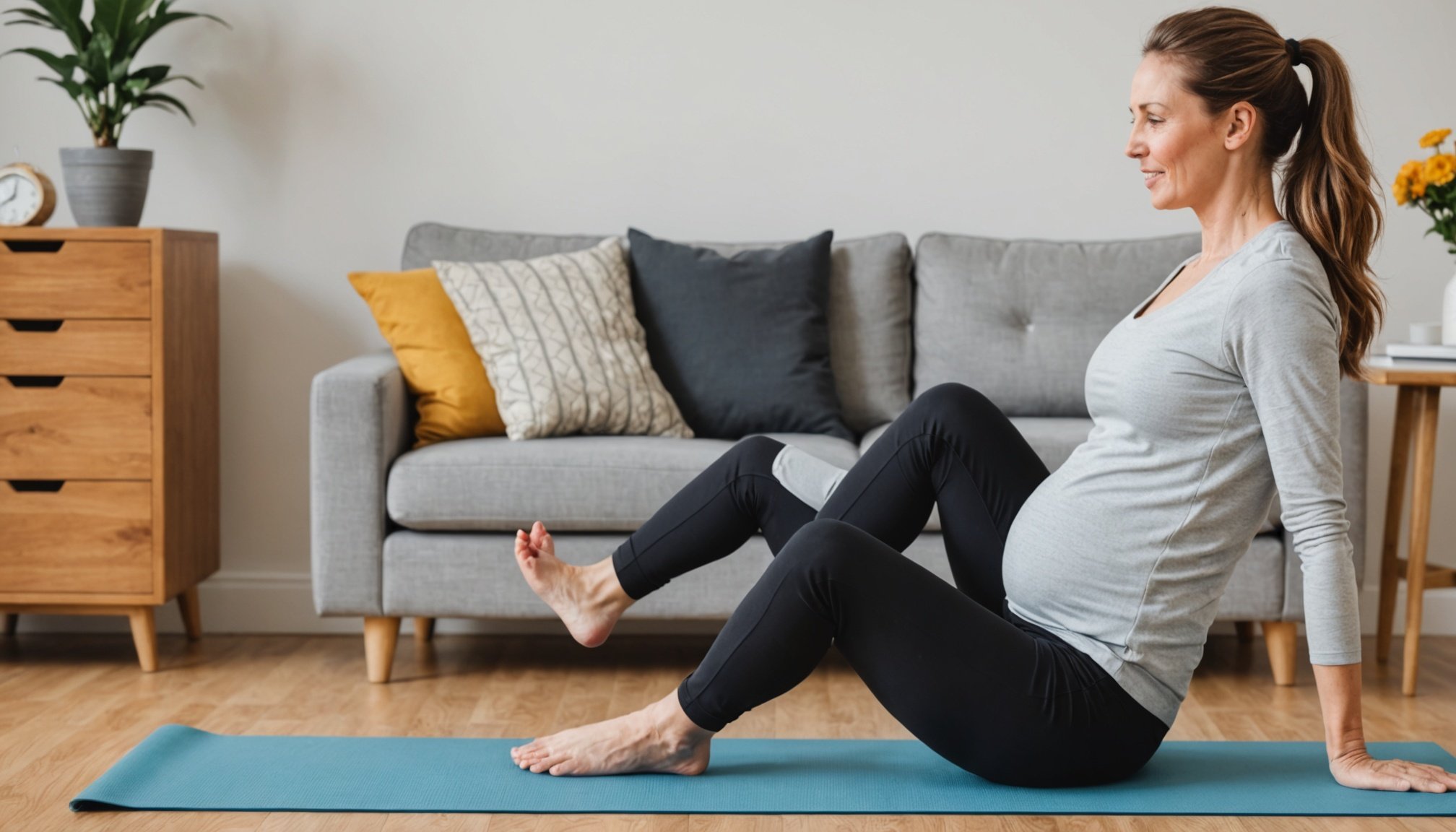Essential Pelvic Stability Exercises for Expecting Mothers in the UK: Boost Your Well-Being!
Understanding the Importance of Pelvic Stability During Pregnancy
When you’re expecting a baby, your body undergoes a multitude of changes, some of which can be quite challenging. One of the critical areas that often gets overlooked but is crucial for a healthy pregnancy and postpartum recovery is the pelvic floor. The pelvic floor muscles play a vital role in supporting your bladder, bowel, and uterus, and maintaining their strength can significantly impact your overall health and well-being during and after pregnancy.
“Pregnancy is a time of momentous change in a woman’s body,” notes a women’s health physiotherapist. “The changes to a woman’s weight and posture that come with pregnancy can create aches and pains, particularly in the lower back and pelvic girdle”.
In the same genre : Essential Mental Health Supports for Expectant Teen Mothers in the UK: A Comprehensive Guide
Common Pregnancy Problems and How Exercises Can Help
During pregnancy, women often experience a range of symptoms that can be managed or even prevented with the right exercises.
Back Pain and Pelvic Girdle Pain
Back pain and pelvic girdle pain are common complaints among pregnant women. The softening of ligaments and the additional weight gain can strain the joints and lower back, leading to discomfort. Exercises that focus on strengthening the back and core muscles, such as Pilates or pregnancy yoga, can be highly beneficial. Swimming is another excellent option as it supports the joints and spine without putting excessive strain on them.
Additional reading : Essential UK Guidelines for Fetal Spinal Abnormality Screening: What Expecting Parents Need to Know
Urinary Incontinence
Urinary incontinence, often referred to as stress incontinence, is another issue many pregnant women face. This can range from minor leaks to complete loss of bladder control, especially when sneezing, laughing, or coughing. Avoiding carbonated drinks and caffeine, keeping a bladder diary, and most importantly, performing pelvic floor exercises (Kegels) can help manage and prevent this condition.
Constipation and Cramp
Constipation and muscle cramps are also frequent issues. Drinking plenty of water, eating a high-fiber diet, and maintaining good toileting posture can help prevent constipation. For cramps, regular leg stretches, improving circulation through ankle and leg movements, and ensuring adequate intake of electrolytes like potassium, sodium, calcium, and magnesium are recommended.
Key Exercises for Pelvic Stability
Here are some essential exercises that can help maintain pelvic stability and overall health during pregnancy:
Pelvic Floor Exercises (Kegels)
- Technique: Squeeze the muscles as if you are trying to stop the urine and passing of gas simultaneously. Hold the contraction for 8-12 counts and then relax for 8-12 counts. Repeat two to three sets several times a day.
- Benefits: Strengthens the muscles that support the bladder, bowel, and uterus, helping with bladder control, sexual pleasure, and postpartum recovery.
Breathing Exercises
- Technique: Deep breathing exercises help ensure the full delivery of oxygen to all parts of your body and promote mental and emotional calmness.
- Benefits: Enhances overall well-being and can help manage stress and anxiety during pregnancy.
Back Exercises
- Technique: Strengthening the muscles that support the spine and pelvis through exercises like bridges, pelvic tilts, and cat-cow stretches.
- Benefits: Alleviates lower back pain and improves posture, reducing the strain on the back and pelvic girdle.
Abdominal Exercises
- Technique: Engaging in exercises that keep the abdominal muscles strong, such as gentle crunches and leg raises.
- Benefits: Helps prevent diastasis recti (the separation of abdominal muscles) and supports the growing baby.
Posture Work
- Technique: Maintaining good posture through exercises that improve spinal alignment and balance.
- Benefits: Reduces excessive strain on the back and lower back pain, ensuring proper spinal alignment.
The Role of Antenatal Physiotherapy
Antenatal physiotherapy is a valuable resource for pregnant women, offering a range of benefits that extend beyond just exercise.
Comprehensive Assessments
- Posture and Joints: Assessment of your posture and joints to identify any potential issues.
- Pelvic Floor Muscles: Internal and external vaginal assessment of your pelvic floor muscles, including guidance on how to correctly contract and relax them.
Treatment and Advice
- Pain Management: Treatment for hip, pelvic, coccyx, or back pain through techniques like soft tissue massage, gentle joint mobilization, and manual therapy.
- Labour Preparation: Advice on how to prepare your pelvic floor and pelvis for delivery.
- Postpartum Recovery: Tips for a safe and quick recovery postnatally, including a Mummy MOT after giving birth.
Practical Tips for Incorporating These Exercises
Here are some practical tips to help you incorporate these exercises into your daily routine:
- Start Early: Begin your exercise routine as early as possible in your pregnancy to prevent antenatal problems and prepare your body for birth and postpartum recovery.
- Consult a Professional: Consider a Pregnancy MOT with a women’s health physiotherapist to get personalized advice and exercises tailored to your needs.
- Stay Hydrated: Keep hydrated to help with overall health and to prevent constipation and muscle cramps.
- Monitor Your Progress: Keep a bladder diary to track any urinary incontinence and plan your day accordingly.
Table: Benefits of Key Exercises During Pregnancy
| Exercise | Technique | Benefits |
|---|---|---|
| Pelvic Floor Exercises (Kegels) | Squeeze muscles as if stopping urine and gas; hold for 8-12 counts, relax for 8-12 counts | Strengthens bladder, bowel, and uterus support; improves bladder control and sexual pleasure |
| Breathing Exercises | Deep breathing | Promotes mental and emotional calmness; ensures full oxygen delivery |
| Back Exercises | Strengthening spine and pelvis muscles | Alleviates lower back pain; improves posture |
| Abdominal Exercises | Gentle crunches and leg raises | Prevents diastasis recti; supports growing baby |
| Posture Work | Maintaining good posture | Reduces back strain; improves spinal alignment |
Postpartum Considerations
After giving birth, it’s crucial to continue focusing on your pelvic health to ensure a smooth recovery and prevent long-term issues.
When to Start Postpartum Exercises
- You can start pelvic floor exercises (Kegels) after 6 weeks postpartum, as advised by your doctor. This helps in healing the weakened pelvic muscles and preventing issues like urinary incontinence and pelvic organ prolapse.
Red Flags for Pelvic Floor Dysfunction
- Be aware of symptoms such as urinary or fecal incontinence, pressure or discomfort in the lower abdomen or pelvic floor, diastasis recti, low back pain, hip pain, and painful sex. If you experience any of these, consult your healthcare provider or a women’s health physiotherapist.
Maintaining pelvic stability during pregnancy is not just about managing symptoms; it’s about ensuring a healthy pregnancy, a smoother birth experience, and a quicker postpartum recovery. By incorporating exercises like Kegels, breathing exercises, back exercises, abdominal exercises, and posture work into your routine, you can significantly improve your overall health and well-being.
“Exercise is very important in pregnancy for a wealth of benefits,” emphasizes a women’s health physiotherapist. “It reduces the risk of gestational diabetes, high blood pressure, and pre-eclampsia; maintains strong heart, lungs, and muscles; and even supports psychological wellbeing”.
Remember, it’s always better to prevent antenatal problems than to try and cure them later. So, take the first step today and invest in your pelvic health – your body, and your baby, will thank you.











